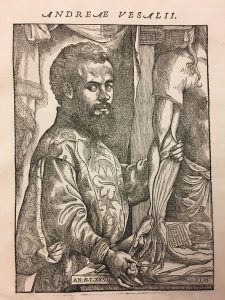Flemish physician Andreas Vesalius (1514-1564) combined rigorous science with publishing technology to create what has perhaps come to be known as the world’s most influential book of anatomy, the De Humani Corporis Fabrica. The work brought startling new light into the world of medicine and art alike, and the man himself was both honoured and criticized for his approach. Indeed, the legacy of his work would linger into the next millennium.

Woodcut portrait of Andreas Vesalius from De Humani Corporis Fabrica, 1543 (UBC Rare Books and Special Collections)
Born in Brussels on the 31st of December in 1514, Vesalius came from a long line of physicians: his great-grandfather was physician to Brussels, his grandfather served Mary of Burgundy, and his father was apothecary to Margaret of Austria and the Emperor Charles V (Saunders and O’Malley 11).
Anatomical Studies
Suffice to say, Vesalius’ family library was extensive and he was quick to follow those before him. In 1529, he began his studies in language and philosophy at the University of Louvain. In 1533, he set out to the University of Paris to study medicine under Jacob Sylvius and Johann Guinter von Andernach. At the age of 23, he was granted a Doctorate of Medicine and appointed Professor of Surgery at the University of Padua, Italy (Saunders and O’Malley 14).
Vesalius was to later look down on his time at the University of Paris for the school’s inability to provide him sufficient access to dissection. When the school was established in 1477, no provision was made for teaching anatomy by dissection, and the dissections that did occur in Vesalius’ time were devastatingly infrequent. Instead, his education in anatomy was largely gained from textbooks featuring the translated works of classical authors, as well as from disarticulated bones when he could find them (Saunders and O’Malley 13). At the time, medicine was dominated by the writings of Galen, a Greek physician of the second century (Clark 303). Like any other student of his time, Vesalius accepted the anatomical teachings of Galen, a figure he would later challenge through physical observation of the body (Saunders and O’Malley 14).
Challenging Tradition
It was during his time as a lecturer in Padua that Vesalius took concrete steps away from traditional, Galenic methods of study. Unlike a traditional reliance on text and animal cadavers, Vesalius was firm in his belief that studies of human anatomy be learned through the hands-on experience of human dissection (Karger Medical and Scientific Publishers).
Vesalius faced criticism– his former teacher Sylvius was particularly harsh, accusing him of rejecting the institution of Galen completely (Karger Medical and Scientific Publishers). However, Vesalius was quick to defend his methods. In his publication, Epistle on the China Root, he argued for the correction of Galen’s anatomy where it differed from physical observation. Indeed, Vesalius’ greatness stemmed from his refusal to blindly accept the teachings of Greco-Roman authorities, choosing to seek corroboration instead.
